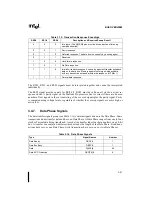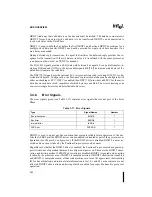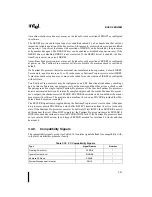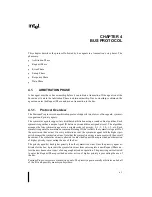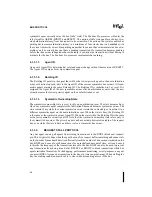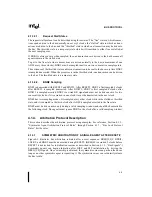
3-16
BUS OVERVIEW
The ATTR[7:0]# pins describe the cache attributes. They are driven based on the Memory Type
Range Register attributes and the Page Table attributes as described in Table 3-8. See Chapter 6,
Range Registers for a description of the memory types.
The DID[7:0]# signals contain the request agent ID on bits DID[6:4]#, the transaction ID on
DID[3:0]#, and the agent type on DID[7]#. Symmetric agents use an agent type of 0. All priority
agents use an agent type of 1. Every deferrable transaction (DEN# asserted) issued on the Pen-
tium Pro processor bus which has not been guaranteed completion will have a unique Deferred
ID. After one of these transactions passes its Snoop Result Phase without DEFER# asserted, its
Deferred ID may be reused. During a deferred reply transaction, the Deferred ID of the agent
that deferred the original transaction is driven instead of an address.
The Byte Enables BE[7:0]# are used to determine which bytes of data should be transferred if
the data transfer is less than 8 bytes wide. BE7# applies to D[63:56], BE0# applies to D[7:0].
The byte enables are also used for special transaction encoding (see Table 3-10).
Table 3-8. Memory Range Register Signal Encoding
ATTR[7:0]#
Memory Type
Description
00000000
UC
UnCacheable
00000100
WC
Write-combining
00000101
WT
WriteThrough
00000110
WP
WriiteProtect
00000111
WB
WriteBack
All others
Reserved
Table 3-9. DID[7:0]# Encoding
DID[7]#
DID[6:4]#
DID[3:0]#
Agent Type
Agent ID
Transaction ID
Summary of Contents for Pentium Pro Family
Page 17: ...1 Component Introduction ...
Page 26: ...2 Pentium Pro Processor Architecture Overview ...
Page 27: ......
Page 36: ...3 Bus Overview ...
Page 62: ...4 Bus Protocol ...
Page 105: ...5 Bus Transactions and Operations ...
Page 126: ...6 Range Registers ...
Page 131: ...7 Cache Protocol ...
Page 135: ...8 Data Integrity ...
Page 148: ...9 Configuration ...
Page 161: ...10 Pentium Pro Processor Test Access Port TAP ...
Page 172: ...11 Electrical Specifications ...
Page 201: ...12 GTL Interface Specification ...
Page 229: ...13 3 3V Tolerant Signal Quality Specifications ...
Page 233: ...14 Thermal Specifications ...
Page 239: ...15 Mechanical Specifications ...
Page 241: ...15 2 MECHANICAL SPECIFICATIONS s Figure 15 1 Package Dimensions Bottom View ...
Page 252: ...16 Tools ...
Page 260: ...16 8 TOOLS Figure 16 4 Generic MP System Layout for Debug Port Connection ...
Page 264: ...17 OverDrive Processor Socket Specification ...
Page 290: ...A Signals Reference ...
Page 320: ...Index ...
Page 328: ......




















